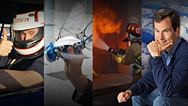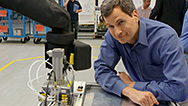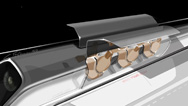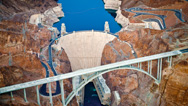Super Fast Cameras
- Posted 11.07.13
- NOVA
A remarkable camera at MIT uses a technique called "Femto-Photography" that captures a trillion frames per second. Using this method, the camera can freeze light in motion and even see around corners. Host David Pogue went to the MIT Media Lab to see this rapid-fire camera at work.
Transcript
Super Fast Cameras
November 7, 2013
DAVID POGUE: It was here at MIT in the early 1960s that Professor Harold Edgerton pushed the boundaries of high-speed photography. He was my Uncle Harold. When I was a kid he used to show me the coolest pictures. Like this famous example. A 2000 mile-an-hour bullet rendered seemingly motionless.
Well, 60 years later, a team of scientists here at MIT have outdone my Uncle Harold.
CHRISTOPHER BARSI: This is actually an inspiration for our own work. The only difference is that Edgerton used a bullet made of copper and lead, whereas we use bullets of light.
DAVID POGUE: They’ve created a camera so fast it slows to a crawl the fastest moving thing in the universe: light.
CHRISTOPHER BARSI: The camera has a resolution of a trillionth of a frame per second. And so we can actually observe light as it goes through this scene.
DAVID POGUE: A trillion frames per second?
CHRISTOPHER BARSI: Uh huh.
DAVID POGUE: At that speed, a flash of light on a still life is transformed into a journey.
CHRISTOPHER BARSI: We’ll see light coming in by its reflection off the floor.
DAVID POGUE: Oh wow.
CHRISTOPHER BARSI: As the light wave propagates, it will hit the surface of the fruit and we’ll see that light up. And then only after a delay will you see the light hit the wall behind it, and only after another delay will you actually see the shadow behind it.
DAVID POGUE: Wait, so the shadow doesn’t appear instantaneously?
CHRISTOPHER BARSI: That’s right, because the wall is farther away. It takes light a longer time to reach it.
DAVID POGUE: That’s crazy.
CHRISTOPHER BARSI: So let me show you another example.
DAVID POGUE: It may seem unremarkable at first: a soda bottle filled with water. But then, a flash.
CHRISTOPHER BARSI: You see the pulse of light enter in from the left.
DAVID POGUE: This pulse is actually a packet of photons—particles of light.
CHRISTOPHER BARSI: And we could see its energy front sweeping across the bottle from left to right. And eventually the pulse will hit the cap and emit a bright flash.
DAVID POGUE: Just think how fast it was traveling.
CHRISTOPHER BARSI: About 600 million miles per hour.
DAVID POGUE: And how long did that event take in real life?
CHRISTOPHER BARSI: It took a billionth of a second for light to go from one end to the other.
DAVID POGUE: So an event that took a nanosecond has been stretched to…
CHRISTOPHER BARSI: About 20 seconds.
DAVID POGUE: 20 seconds. So that’s a lot of stretching.
CHRISTOPHER BARSI: This is super slow motion.
DAVID POGUE: Put another way, if you were to film that iconic apple with this camera, and made a movie of the bullet entering the picture, going through the apple, and out the other side.
CHRISTOPHER BARSI: It would take about a year to watch this entire movie.
DAVID POGUE: This would take a year to watch?
CHRISTOPHER BARSI: That’s right. Yes.
DAVID POGUE: Oh, I recognize this set-up. So how exactly does this super fast camera slow things down?
CHRISTOPHER BARSI: We shined laser light inside the bottle. You can actually see the beam.
DAVID POGUE: It looks like a continuous ray of light. But it’s not.
CHRISTOPHER BARSI: The laser light emits a train of pulses very fast.
DAVID POGUE: The object is to capture just one of these pulses as it enters the bottle. To get this image, they actually have to take 500 separate pictures. Each just photographing a narrow slice of the scene.
CHRISTOPHER BARSI: The camera looks at the scene through this mirror system, which rotates. And as the mirror moves, we record a different slice of the bottle at a time.
DAVID POGUE: So, in order to get a complete picture, you’d need five hundred slices of it.
CHRISTOPHER BARSI: Exactly.
DAVID POGUE: But how do you capture a single burst of light if you have to film it 500 times?
CHRISTOPHER BARSI: What we do is we don’t shine just one laser pulse. We rely on the fact that the laser is shooting out pulses periodically in time, over and over again. For each laser pulse, the camera records one line of the scene at a time.
DAVID POGUE: And the fact that each pulse looks the same as the last, that’s why the finished movie looks like it’s just one pulse?
CHRISTOPHER BARSI: Yeah, we stitch it all together.
DAVID POGUE: Taking it a step further, when you combine the camera this fast with information processing, it opens up some interesting possibilities.
This camera over here can somehow see around the corner?
CHRISTOPHER BARSI: Precisely.
DAVID POGUE: How does that work?
CHRISTOPHER BARSI: Well, what we do is we take our laser beam and we shine it onto another wall. That light bounces off the wall and scatters in all different directions.
DAVID POGUE: Some of that light hits the mannequin. Because the camera is so fast, it can record the difference in time it takes for this path, or this path. Each of the billions of paths of bounced light that reach it.
CHRISTOPHER BARSI: So, based on the fact that we know how fast light travels, we can build computer software to actually place all the light back where it came from on the object.
DAVID POGUE: Digitally reconstructing it.
CHRISTOPHER BARSI: After the reconstruction, it actually looks like an image of our object. Like this.
DAVID POGUE: [Exclamation!]
And with more processing, a 3D image. It’s similar to sonar, where an image is reconstructed from reflected sound waves.
CHRISTOPHER BARSI: It’s similar, but in sonar, the object or the ground floor you want to look at still has to be in the direct line of view of the camera. In this case, you no longer have that restriction.
DAVID POGUE: So it has potential for use in fire and rescue, or for automobiles to detect approaching vehicles around corners. Or in medicine, to visualize the inside of a person’s body. I think Uncle Harold would be proud.
Credits
PRODUCTION CREDITS
- Director
- Vincent Liota
- Associate Producer
- Karinna Sjo-Gaber
- Camera
- Thomas Danielczik
- Sound
- Fred Burnham
- Animation
- Smash5
Vincent Liota - Additional Editing
- Anna Rothschild
- Original Footage
- © WGBH Educational Foundation 2013
- For more on Femto-Photography and a list of scientific collaborators, please visit the following links.
- http://dl.acm.org/citation.cfm?id=2461928
http://dl.acm.org/citation.cfm?id=2461928
http://web.media.mit.edu/~raskar/cornar/
http://web.media.mit.edu/~raskar/trillionfps/
MEDIA CREDITS
- (Femto-Photography Demonstrations)
- A. Velten, et al., 2013.
- (How to Make Applesauce at MIT)
- Courtesy MIT Museum
- (man holds bright flash bulb in hand, slow motion)
- © iStock/morganl
- (photo of the camera and a scene)
- © Andreas Velten
- (concept artwork demonstrating uses of the technology)
- © Tiago Allen
IMAGE
- (main image: light in bottle)
- © WGBH Educational Foundation 2013
Related Links
-

Making More Stuff
Host David Pogue hits the road to explore the frontiers of invention and innovation.
-

Making More Stuff Quiz
Could robots do search and rescue? Can we grow batteries? Take the quiz and find out.
-

Here to There, Fast
Elon Musk is selling the hyperloop as "a fifth mode after planes, trains, cars and boats." But is it much different?
-

Infrastructure's Unsung Role
Fast and efficient roads, rails, and airports will keep us moving quickly, but only if we continue to invest in them.

